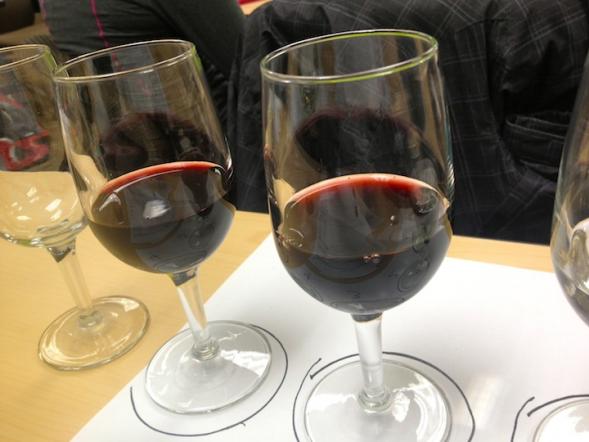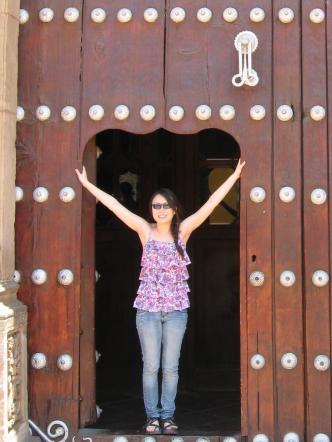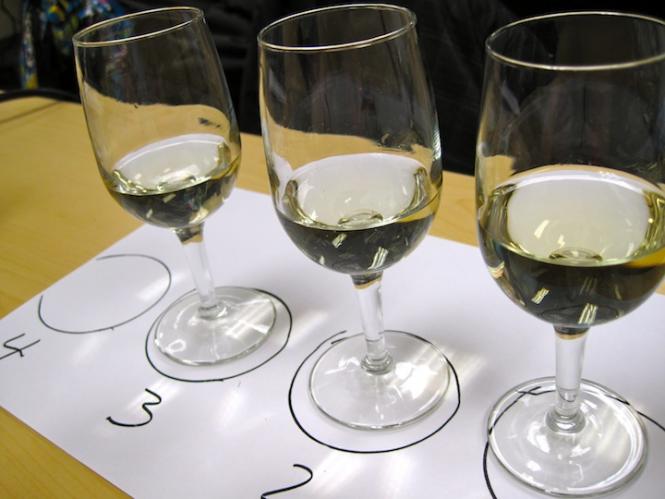Now that it’s a few weeks into my second semester of culinary school (you can read the introduction to the series here), I’ve got a few wine classes under my belt. Class is truly an introduction to wine, and a non-pretentionous one, at that. There are no wine snobs in our class. Only students like myself, who enjoy drinking wine but admit to knowing nothing about it. When I introduced myself to the class, I included the fact that the first adult beverage I bought and consumed upon turning 21 was a bottle of Boone’s Farm, in the Blue Hawaiian flavor to be exact. My roommate and I later graduated to Arbor Mist, which made us feel pretty darn sophisticated, and then eventually onto Sangria Wine Cubes from Target that I drank, paired with pickle chips and hot wings. I enjoy most any wine these days and look forward to at least becoming wine literate.
As much as I enjoy learning and reading about food, I’ve always been too intimidated to embark into the world of wine alone. The first two chapters of our class textbook, Exploring Wine, left me dizzy. The content is dense. Scientific and detailed. I felt slightly vindicated that I had never tried to learn about wine on my own. “I knew it was intimidating. I just knew it,” I thought. Then closed my book. Fortunately, our class demystifies wine in a more digestible fashion than reading a dense textbook alone.
 Before the
wine even reached the classroom, our teacher had the talk with us. Under no circumstances were
any of us supposed to drink too much and become inebriated. We were encouraged
to sip and spit into a separate glass, instead of feeling obligated to finish
all of our wine samples. Then, he relayed the story of having attended a scotch
tasting gone bad; foiled by an individual who slammed each sample. We were not
to do that, either. These guidelines were put into writing and then we signed
them in blood.
Before the
wine even reached the classroom, our teacher had the talk with us. Under no circumstances were
any of us supposed to drink too much and become inebriated. We were encouraged
to sip and spit into a separate glass, instead of feeling obligated to finish
all of our wine samples. Then, he relayed the story of having attended a scotch
tasting gone bad; foiled by an individual who slammed each sample. We were not
to do that, either. These guidelines were put into writing and then we signed
them in blood.
In reality, no one actually sips and spits. Instead, I, like many others, only drink enough to taste and then pour my leftovers into a discard bucket. At the end of one class, a young man I didn’t know well asked me if he could have my glass. I looked down at the glass in which I had poured my leftovers and tried to explain it wasn’t a single sample. Rather, it was my backwash. He replied, “Okay,” and then asked again. I gave him my glass, assuming he was offering to put it away for me. Instead, he tilted back his head and flung the contents back like a shot. Now, I personally escort my leftovers to the discard bucket. The unfinished bottles are locked in a cabinet, and we use them to cook with when our recipes dictate.
When the wine tasting commences, we set our place with a white piece of paper drawn with circles numbered to designate each wine sample. The white color provides a neutral backdrop so we can more easily compare the wines’ colors and viscosities. We take turns practicing opening wine bottles in the most professional way possible and pouring perfect 1.5 - 2 ounce samples with serviettes draped over our arms. Pourers must serve themselves last as an incentive to make each pour as even as possible.
 Our first classes have
helped us become more literate with the process of tasting wine and reading
wine labels. We are guided by worksheets that make us examine the wine labels
for basics such as where the wine was produced, the name of producer, and what
type(s) of grapes were used. I realize there is a lot more that goes into
understanding wine labels, such as knowing the definitions and regulations that
may vary by country. At least this gives us a basic understanding from which we
can build. This same sheet also guides us along the initial tasting process by
walking us through variables from the wine’s appearance to its smell to the
length of its finish. I note the wines I like the most and by the end of our
class, we’ll have a binder full of these forms for future reference. The only
category our instructor withholds from us until the end of class is the price
of each wine; he says that knowledge of a wine’s price has been known to affect
one’s perception of its flavor. So far, our wines hover between $8 - 12.
Our first classes have
helped us become more literate with the process of tasting wine and reading
wine labels. We are guided by worksheets that make us examine the wine labels
for basics such as where the wine was produced, the name of producer, and what
type(s) of grapes were used. I realize there is a lot more that goes into
understanding wine labels, such as knowing the definitions and regulations that
may vary by country. At least this gives us a basic understanding from which we
can build. This same sheet also guides us along the initial tasting process by
walking us through variables from the wine’s appearance to its smell to the
length of its finish. I note the wines I like the most and by the end of our
class, we’ll have a binder full of these forms for future reference. The only
category our instructor withholds from us until the end of class is the price
of each wine; he says that knowledge of a wine’s price has been known to affect
one’s perception of its flavor. So far, our wines hover between $8 - 12.
 I’ve often seen individuals
swirling, sniffing, and slurping wine during tastings and wondered what on
earth are they were doing. I’ll admit I’ve mimicked this process and pretended
like I knew what I was doing on rare occasions when my husband and I have
ordered a bottle of wine at a restaurant or when I’ve visited wine tasting
booths at events. For example, we learned that the act of swirling is more than
just putting on a show – it actually mixes oxygen into the wine and releases
aromatic compounds. We experienced this for ourselves, smelling and tasting our
wines before and after aeration. Many of my classmates claim they do not like
red wines of any kind, preferring what I consider sickly sweet Rieslings. When
our teacher brought out the Cabernet Sauvignon, I rejoiced. Finally, some reds.
Even the students who most adamantly claimed to dislike red wines could palate
the dark, heavy cabernet when aerated – after the aeration, it tasted softer
and less harsh.
I’ve often seen individuals
swirling, sniffing, and slurping wine during tastings and wondered what on
earth are they were doing. I’ll admit I’ve mimicked this process and pretended
like I knew what I was doing on rare occasions when my husband and I have
ordered a bottle of wine at a restaurant or when I’ve visited wine tasting
booths at events. For example, we learned that the act of swirling is more than
just putting on a show – it actually mixes oxygen into the wine and releases
aromatic compounds. We experienced this for ourselves, smelling and tasting our
wines before and after aeration. Many of my classmates claim they do not like
red wines of any kind, preferring what I consider sickly sweet Rieslings. When
our teacher brought out the Cabernet Sauvignon, I rejoiced. Finally, some reds.
Even the students who most adamantly claimed to dislike red wines could palate
the dark, heavy cabernet when aerated – after the aeration, it tasted softer
and less harsh.
One of our first and most enjoyable class exercises involved smelling. I was surprised to find that a glass of wine really does smell differently when I sniffed top of the glasses, versus when I stuck my nose deep within. The scent also varied when I deeply inhaled or took repetitive “cocker spaniel sniffs.” This technique is illustrated by this short instructional video of Jane Nickles, a certified wine instructor and writer. Our instructor occasionally uses her videos to illustrate certain concepts. They’re straightforward and concise, only lasting a few minutes at the most. He also gave us a big tip when he said that he believes most reds contain hints of “cherry, berry, smoke, and spice.” Then, he told us to throw that line out with confidence at the next wine tasting we attended.
 Our first
classes introduced us to Rieslings and Chardonnays. To help us hone our
olfactory senses, our instructor set up smell-testing stations around the
kitchen. We wandered from station to station, and sniffed wine glasses that sat
upon little vials of scents one might find in white wines. Die-hard wine
connoisseurs can actually purchase their own wine aroma kit such as this example. The least expensive kit I found cost about $60, while many
others soared into the hundreds of dollars. Our instructor mentioned the best
way to practice smelling was to go to one’s favorite grocery store and work around
the produce section sniffing each fruit. This would certainly be less
expensive, though I wonder how long one could get away with this.
Our first
classes introduced us to Rieslings and Chardonnays. To help us hone our
olfactory senses, our instructor set up smell-testing stations around the
kitchen. We wandered from station to station, and sniffed wine glasses that sat
upon little vials of scents one might find in white wines. Die-hard wine
connoisseurs can actually purchase their own wine aroma kit such as this example. The least expensive kit I found cost about $60, while many
others soared into the hundreds of dollars. Our instructor mentioned the best
way to practice smelling was to go to one’s favorite grocery store and work around
the produce section sniffing each fruit. This would certainly be less
expensive, though I wonder how long one could get away with this.
I was surprised to find that out of the 14 scents, I only guessed one correctly. Each smelled familiar, but I just couldn’t identify them. Besides rose, which was the only one I identified, the scents also included pear, peach, watermelon, and pineapple. Then, we tried our hand at real wines. I remember sniffing my first glass, both from a distance and deep within. The strongest aroma struck me as pineapple. I moved on to the second glass that also smelled like pineapple. And so did the third. I felt resigned to the fact that all I could say was “pineapple.” It’s funny that all those white wines strike me as pineapple, but I couldn’t identify pineapple in the sniff test.
In later classes, white wines still smelled mostly like pineapple to me, but I am now able to sense the variations a little better. Instead of just pineapple, I might smell a little melon or even some floral notes. I was tickled pink when I took a look at our list of aromas we could look for in Sauvignon Blancs and noticed “cat pee.” Apparently, cat pee is legitimately a note that some find in Sauvignon Blanc. It’s called pipi du chat in French and there’s even an actual wine produced by Coopers Creek called Cat’s Pee on a Goosesbury Bush. There’s your fun fact of the day.
As I alluded to in the beginning, I’m not sure my interest in wine will ever grow as large as my passion for food. I think I can proceed with more patience if I think of wine studies as having its own language and unique set of tools. This brings to mind one of Ruth Reichl memoirs (I think it was Garlic and Sapphires) in which she describes her journey into wine. She acknowledges the same puzzlement I’ve felt upon hearing others poetically wax on about tasting things such as fields full of wildflowers or brisk fall days in their glasses and how she, too, eventually learned how to put language to wine. At the moment, I may taste mostly pineapple, but eventually I’ll also find the symphonies and wildflowers in my glass.

Jeni Hill grew up in the Twin Cities and recently moved to Fargo. Her two sustaining passions are food and writing and she combines the two whenever she gets the chance. Jeni believes food is never just about the food and considers it the finest medium to connect with others. When she is not crafting contributions to Simple Good & Tasty, she may be posting to her blog An Herbalist Eats, 20food, or Fargo's High Plains Reader. Her last series for SGT was Farm to Fork, a CSA Series.

